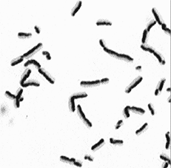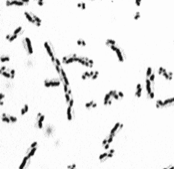Laboratory Confirmation of the Diagnosis of Bloom’s Syndrome
Cytogenetic Analysis
Confirmation of the clinical diagnosis ordinarily is cytogenetic. An excessive amount of so-called chromosome breakage is present: The numbers of chromatid gaps, breaks, and rearrangements as well as of a specific type of interchange configuration (as pictured immediately below) are greatly increased in frequency in BSyn cells. Also, the number of sister-chromatid exchanges (SCEs) is strikingly, in fact diagnostically, elevated in blood lymphocytes in short-term culture (figures below). However, in some persons with BSyn a population of circulating lymphocytes has a normal SCE rate! Although such normal-SCE lymphocytes usually are in the minority, in theory a major proportion, possibly even all of the lymphocytes in the circulation, would be found to have a low (i.e., a normal) SCE rate. Therefore, if the clinical suspicion of BSyn in a given individual is strong but the cytogenetic analysis of blood cells fails to confirm that diagnosis, resort is made to the SCE-rate determination in cultured dermal fibroblasts, for there, only high-SCE cells have ever been found in persons with BSyn.
 A symmetrical Qr (quadriradial configuration).
A symmetrical Qr (quadriradial configuration).
Below: Two blood lymphocytes in metaphase of mitosis, the right from a person with BSyn, the left from a control. The cells were cultured for two cell-division cycles in BrdU-containing medium, harvested at mitosis, and stained so that the two sister chromatids of each chromosome are stained differently -- one dark, one light -- making points of exchange between sister chromatids identifiable.
 Control. A few SCEs (sister-chromatid exchanges).
Control. A few SCEs (sister-chromatid exchanges).
 Bloom’s syndrome. Many SCEs.
Bloom’s syndrome. Many SCEs.
Molecular Analysis
In addition to the use of cytogenetics to confirm (or disaffirm) the diagnosis of BSyn, molecular analysis of the gene BLM (see below) can be employed. A BSyn-causing mutation will be demonstrable in the gene BLM that was inherited from each of the parents.
Top of page